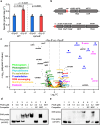Phosphorus deficiency alleviates iron limitation in Synechocystis cyanobacteria through direct PhoB-mediated gene regulation
- PMID: 38789507
- PMCID: PMC11126600
- DOI: 10.1038/s41467-024-48847-4
Phosphorus deficiency alleviates iron limitation in Synechocystis cyanobacteria through direct PhoB-mediated gene regulation
Abstract
Iron and phosphorus are essential nutrients that exist at low concentrations in surface waters and may be co-limiting resources for phytoplankton growth. Here, we show that phosphorus deficiency increases the growth of iron-limited cyanobacteria (Synechocystis sp. PCC 6803) through a PhoB-mediated regulatory network. We find that PhoB, in addition to its well-recognized role in controlling phosphate homeostasis, also regulates key metabolic processes crucial for iron-limited cyanobacteria, including ROS detoxification and iron uptake. Transcript abundances of PhoB-targeted genes are enriched in samples from phosphorus-depleted seawater, and a conserved PhoB-binding site is widely present in the promoters of the target genes, suggesting that the PhoB-mediated regulation may be highly conserved. Our findings provide molecular insights into the responses of cyanobacteria to simultaneous iron/phosphorus nutrient limitation.
© 2024. The Author(s).
Conflict of interest statement
The authors declare no competing interests.
Figures








Similar articles
-
A global transcriptional activator involved in the iron homeostasis in cyanobacteria.Sci Adv. 2024 Jul 5;10(27):eadl6428. doi: 10.1126/sciadv.adl6428. Epub 2024 Jul 3. Sci Adv. 2024. PMID: 38959319 Free PMC article.
-
Iron deprivation in Synechocystis: inference of pathways, non-coding RNAs, and regulatory elements from comprehensive expression profiling.G3 (Bethesda). 2012 Dec;2(12):1475-95. doi: 10.1534/g3.112.003863. Epub 2012 Dec 1. G3 (Bethesda). 2012. PMID: 23275872 Free PMC article.
-
Outer Membrane Iron Uptake Pathways in the Model Cyanobacterium Synechocystis sp. Strain PCC 6803.Appl Environ Microbiol. 2018 Sep 17;84(19):e01512-18. doi: 10.1128/AEM.01512-18. Print 2018 Oct 1. Appl Environ Microbiol. 2018. PMID: 30076192 Free PMC article.
-
PfsR is a key regulator of iron homeostasis in Synechocystis PCC 6803.PLoS One. 2014 Jul 10;9(7):e101743. doi: 10.1371/journal.pone.0101743. eCollection 2014. PLoS One. 2014. PMID: 25010795 Free PMC article.
-
Molecular Mechanisms for Iron Uptake and Homeostasis in Marine Eukaryotic Phytoplankton.Annu Rev Microbiol. 2024 Nov;78(1):213-232. doi: 10.1146/annurev-micro-041222-023252. Epub 2024 Nov 7. Annu Rev Microbiol. 2024. PMID: 39018471 Review.
Cited by
-
Community Structure, Growth-Promoting Potential, and Genomic Analysis of Seed-Endophytic Bacteria in Stipagrostis pennata.Microorganisms. 2025 Jul 27;13(8):1754. doi: 10.3390/microorganisms13081754. Microorganisms. 2025. PMID: 40871258 Free PMC article.
References
-
- Moore CM, et al. Processes and patterns of oceanic nutrient limitation. Nat. Geosci. 2013;6:701–710. doi: 10.1038/ngeo1765. - DOI
-
- Duhamel S, et al. Phosphorus as an integral component of global marine biogeochemistry. Nat. Geosci. 2021;14:359–368. doi: 10.1038/s41561-021-00755-8. - DOI
-
- Shaked Y, et al. Co-acquisition of mineral-bound iron and phosphorus by natural Trichodesmium colonies. Limnol. Oceanogr. 2023;5:1064–1077. doi: 10.1002/lno.12329. - DOI
MeSH terms
Substances
Grants and funding
LinkOut - more resources
Full Text Sources
Medical
Molecular Biology Databases

